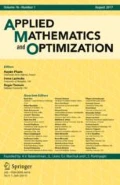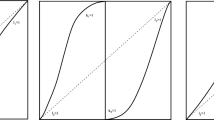Abstract
In this paper we consider symmetric games where a large number of players can be in any one of d states. We derive a limiting mean field model and characterize its main properties. This mean field limit is a system of coupled ordinary differential equations with initial-terminal data. For this mean field problem we prove a trend to equilibrium theorem, that is convergence, in an appropriate limit, to stationary solutions. Then we study an N+1-player problem, which the mean field model attempts to approximate. Our main result is the convergence as N→∞ of the mean field model and an estimate of the rate of convergence. We end the paper with some further examples for potential mean field games.
Similar content being viewed by others
References
Achdou, Y., Dolcetta, I.C.: Mean field games: numerical methods. Preprint (2010)
Adlakha, S., Johari, R., Weintraub, G.Y.: Equilibria of dynamic games with many players: existence, approximation, and market structure. Submitted for publication (2011)
Salomon, J., Lachapelle, A., Turinici, G.: Computation of mean field equilibria in economics
Cardaliaguet, P.: Notes on Mean Field Games (2010)
Gomes, D., Mohr, J., Souza, R.R.: Discrete time, finite state space mean field games. J. Math. Pures Appl. 93(2), 308–328 (2010)
Gomes, D., Pires, G.E., Sanchez-Morgado, H.: A-priori estimates for stationary mean-field games. Preprint (2011)
Gomes, D., Sanchez-Morgado, H.: A stochastic Evans-Aronsson problem. Preprint (2011)
Gueant, O.: Mean field games and applications to economics. Ph.D. thesis, Université Paris Dauphine, Paris (2009)
Gueant, O.: An existence and uniqueness result for mean field games with congestion effect on graphs. Preprint (2011)
Gueant, O.: From infinity to one: the reduction of some mean field games to a global control problem. Preprint (2011)
Huang, M., Caines, P.E., Malhamé, R.P.: Large-population cost-coupled LQG problems with nonuniform agents: individual-mass behavior and decentralized ϵ-Nash equilibria. IEEE Trans. Autom. Control 52(9), 1560–1571 (2007)
Huang, M., Malhamé, R.P., Caines, P.E.: Large population stochastic dynamic games: closed-loop McKean-Vlasov systems and the Nash certainty equivalence principle. Commun. Inf. Syst. 6(3), 221–251 (2006)
Hayel, Y., Tembine, H., Altman, E., El-Azouzi, R.: A Markov decision evolutionary game for individual energy management. In: Advances in Dynamic Games. Ann. Internat. Soc. Dynam. Games, vol. 11, pp. 313–335. Birkhäuser/Springer, New York (2011)
Kapur, S.: Markov perfect equilibria in an N-player war of attrition. Econ. Lett. 47(2), 149–154 (1995)
Kolokoltsov, V.N., Li, J., Yang, W.: Mean field games and nonlinear Markov processes. Preprint (2011)
Kolokoltsov, V.N.: Markov Processes, Semigroups and Generators. Studies in Mathematics, vol. 38. De Gruyter, Berlin (2011)
Livshits, I.: On non-existence of pure strategy Markov perfect equilibrium. Econ. Lett. 76(3), 393–396 (2002)
Lasry, J.-M., Lions, P.-L.: Jeux à champ moyen. I. Le cas stationnaire. C. R. Math. Acad. Sci. Paris 343(9), 619–625 (2006)
Lasry, J.-M., Lions, P.-L.: Jeux à champ moyen. II. Horizon fini et contrôle optimal. C. R. Math. Acad. Sci. Paris 343(10), 679–684 (2006)
Lasry, J.-M., Lions, P.-L.: Mean field games. Jpn. J. Math. 2(1), 229–260 (2007)
Lasry, J.-M., Lions, P.-L.: Mean Field Games. Cahiers de la Chaire Finance et Développement Durable (2007)
Lasry, J.-M., Lions, P.-L., Guéant, O.: Application of mean field games to growth theory. Preprint (2010)
Lasry, J.-M., Lions, P.-L., Guéant, O.: Mean Field Games and Applications. Paris-Princeton Lectures on Mathematical Finance (2010)
Moll, B., Lucas, R.: Knowledge growth and the allocation of time. Preprint (2011)
Maskin, E., Tirole, J.: Markov perfect equilibrium. I. Observable actions. J. Econ. Theory 100(2), 191–219 (2001)
Pakes, A., McGuire, P.: Stochastic algorithms, symmetric Markov perfect equilibrium, and the “curse” of dimensionality. Econometrica 69(5), 1261–1281 (2001)
Pichler, P., Sorger, G.: Wealth distribution and aggregate time-preference: Markov-perfect equilibria in a Ramsey economy. J. Econ. Dyn. Control 33(1), 1–14 (2009)
Sleet, C.: Markov perfect equilibria in industries with complementarities. Econom. Theory 17(2), 371–397 (2001)
Streufert, P.A.: Markov-perfect equilibria in intergenerational games with consistent preferences. J. Econ. Dyn. Control 17(5–6), 929–951 (1993)
Tembine, H., Le Boudec, J.Y., ElAzouzi, R., Altman, E.: In: Proceedings of GameNets, Istanbul, Turkey (2009)
Weintraub, G.Y., Lanier Benkard, C., Van Roy, B.: Markov perfect industry dynamics with many firms. Econometrica 76(6), 1375–1411 (2008)
Author information
Authors and Affiliations
Corresponding author
Additional information
D. Gomes was partially supported by CAMGSD-LARSys through FCT-Portugal and by grants PTDC/MAT-CAL/0749/2012, UTA-CMU/MAT/0007/2009 PTDC/MAT/114397/2009, UTAustin-MAT/0057/2008, and by the bilateral agreement Brazil-Portugal (CAPES-FCT) 248/09.
R.R.S. was partially supported by the bilateral agreement Brazil-Portugal (CAPES-FCT) 248/09.
J.M. was partially supported by the bilateral agreement Brazil-Portugal (CAPES-FCT) 248/09.
Appendix: Auxiliary Results
Appendix: Auxiliary Results
Proof of Proposition 1
To prove the first item we use the definition of h and α ∗ and also that \(v^{i}\sum_{j} \alpha^{*}_{j}(z,\theta,i)=0\) to get
Hence by the definition of h(z+v,θ,i) we have
From this (7) holds and we deduct that if h is differentiable
Note that item (c) is a direct corollary of item (b), since
and the function c is Lipschitz in θ and differentiable in α.
From this point on in this proof we will omit the index i as it is not relevant and simplifies the notation. To prove item (b) we will use the following inequalities, which are consequence of the uniform convexity of c: for all \(\theta, \theta '\in\mathcal{S}^{d}\), \(\alpha', \alpha\in(\mathbb{R}_{0}^{+})^{d}\), \(\sum_{k} \alpha_{k}=\sum_{k} \alpha_{k}'=0\), and \(p,p'\in\mathbb{R}^{d}\), we have
and because α ∗(p,θ) is a minimizer,
We will first prove that α ∗ is uniformly Lipschitz in p: for that, we suppose that θ is fixed. By the definition of α ∗ and (64) we have

hence

Now using (65) we obtain
Therefore
which implies
This shows that α ∗ is uniformly Lipschitz in p.
Now we prove that α ∗ is Lipschitz in θ: for that, we suppose that p is fixed. Again by the definition of α ∗ and by (64) we have

and then
Using (65) we get
As ∇ α c(θ,α) is Lipschitz in the variable θ we have
Therefore
which implies that α ∗ is Lipschitz in θ. □
Proof of Theorem 5
The main tool for proving Theorem 5 is once again the Dynkin Formula, now adapted to the present situation: suppose α and β are two admissible controls.
We recall the infinitesimal generator of the process (i,n) defined in (50). We have

where γ β is defined by (30).
We have that, for any function \(\varphi:I_{d} \times\mathcal{S}^{d}_{N} \times [0,+\infty) \rightarrow{\mathbb{R}}\), C 1 in the last variable, and any t<T,
where A t (i,n) denotes the event i t =i and n t =n.
Now we prove the theorem. In the Dinkyn formula (67) let φ=v. Using the terminal condition \(v^{{\mathbf{i}}_{T}}_{{\mathbf {n}}_{T}}(T)=\psi^{{\mathbf{i}} _{T}} (\frac{{\mathbf{n}}_{T}}{N} )\) we have that, for any admissible control α,
In the next steps we will use the definition of u, given in (31), and then (68), (66), (4) to have

where the last equation holds because v is a solution to the Hamilton-Jacobi equation (32). Note that in this last calculation we are also proving that, for the specific control \(\tilde{\alpha}\) given by (34), we have \(u^{i}_{n}(t,\beta,\tilde{\alpha})=v^{i}_{n}(t)\) which show us that \(\tilde{\alpha}\) is the optimal control and that the objective function \(u^{i}_{n}(t,\beta)\) is given by \(v_{n}^{i}(t)\). □
Proof of Proposition 6
Let u be a solution to (32). Let \(\tilde{u}=u+\rho(T-t)\). Then
Let (i,n,t) be a minimum point of \(\tilde{u}\) on \(I_{d}\times\mathcal {S}^{d}_{N} \times[0,T]\). We have \(\tilde{u}^{i}_{n+e_{jk}}\geq\tilde{u}^{i}_{n}\). This implies \(\gamma_{\beta,kj}^{n,i} (\tilde{u}^{i}_{n+e_{jk}}-\tilde{u}^{i}_{n})\geq0\). We also have \(\tilde{u}^{j}_{n}(t)-\tilde{u}^{i}_{n}(t)\geq0\) hence \(\Delta_{i} \tilde{u}_{n}= (\tilde{u}^{1}_{n}(t)-\tilde{u}^{i}_{n}(t),\ldots,\tilde{u}^{d}_{n}(t)-\tilde{u}^{i}_{n}(t))\geq0\). Hence
because the definition of h(Δ i p,θ,i), with Δ i p≥0. Furthermore, if we take M<ρ<2M we get
This shows that the minimum of \(\tilde{u}\) is achieved at T hence
Similarly, let (i,n,t) be a maximum point of \(\tilde{u}\) on \(I_{d}\times\mathcal {S}^{d}_{N}\times[0,T]\). We have \(\tilde{u}^{i}_{n+e_{jk}}\leq\tilde{u}^{i}_{n}\). This implies \(\gamma_{\beta,kj}^{n,i} (\tilde{u}^{i}_{n+e_{jk}}-\tilde{u}^{i}_{n})\leq0\). We also have \(\Delta_{i} \tilde{u}_{n}\leq0\). Hence
Furthermore, if we take −2M<ρ<−M we get
This shows that the maximum of \(\tilde{u}\) is achieved at T hence
□
Proof Lemma 3
Recall that α ∗(p,θ,i) is Lipschitz in (p,θ). Let K be the corresponding Lipschitz constant. Since ∥p∥ bounded, we have |α ∗(p,.,.)|≤C. Then

□
Proof of Lemma 4
Let z be a solution of (40), and fix ϵ>0. We define \(\tilde{z}= z+\epsilon(t-\nobreak T)\). Hence \(\tilde{z}\) satisfies
Let (m,t) be a maximum point of \(\tilde{z}\) on \(I_{d}\times{\mathcal {S}^{d}_{N}}\times[0,T]\). We have \({\tilde{z}}_{m}(t)\geq{\tilde{z}}_{m'}(t)\) and this implies \(a_{mm'}(t) ({\tilde{z}}_{m'}-{\tilde{z}}_{m})\leq0\) ∀m′. Hence
This shows that the maximum of \(\tilde{z}\) is achieved at T. Therefore, for all (m′,t),
Letting ϵ→0, we get
From this inequality we have the following conclusions:
-
1.
if z(T)≤0, we then have z m′(t)≤0, for all (m′,t), and so z(t)≤0;
-
2.
for all (m′,t),
$$z_{m'}(t)\leq\|z(T)\|_{\infty}. $$
Now we define \(\tilde{z}= z+\epsilon(T-t)\). Hence \(\tilde{z}\) satisfies
Let (m,t) be a minimum point of \(\tilde{z}\) on \(I_{d}\times{\mathcal {S}^{d}_{N}}\times[0,T]\). We have \(a_{mm'}(t) ({\tilde{z}}_{m'}-{\tilde{z}}_{m})\geq0\). Therefore we have
This shows that the minimum of \(\tilde{z}\) is also achieved at T, hence for all (m′,t) we have
Letting ϵ→0, we get z m′(t)≥min m z m (T). Hence
and therefore we have ∥z(t)∥∞≤∥z(T)∥∞. □
Proof of Lemma 6
We note that if t≤s≤T we have K(t,s)K(s,T)=K(t,T), which implies
Hence, using (42) we get
and therefore, by taking T=s we conclude that
Multiplying (43) by K(t,s) and using Lemma 5, we have
Using the identity
which follows from (69), we get
Thus, integrating between t and T, we have
Note that if z(t)=K(t,T)z(T) is a solution of (40) with terminal data z(T)=b, then Lemma 4 implies that ∥z(t)∥∞≤∥z(T)∥∞, hence ∥K(t,T)z(T)∥∞≤∥z(T)∥∞.
Therefore for all \(m\in I_{d}\times{\mathcal{S}}^{d}_{N}\) we have
□
Proof of Lemma 7
Note that (44) implies that v is a monotone decreasing function of s and is equivalent to
This implies by direct integration that
Now
Therefore if we define \(T^{\star}=\frac{1}{2C+4C^{2}+1} \), we have that \(s (\frac{2C}{N} ) \leq0\) if T≤T ⋆. Hence this implies \(v(0) \leq\frac{2C}{N}\), which yields the desired result when we take into account that v is a decreasing function of s. □
Rights and permissions
About this article
Cite this article
Gomes, D.A., Mohr, J. & Souza, R.R. Continuous Time Finite State Mean Field Games. Appl Math Optim 68, 99–143 (2013). https://doi.org/10.1007/s00245-013-9202-8
Published:
Issue Date:
DOI: https://doi.org/10.1007/s00245-013-9202-8




